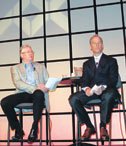Sears Plays Real Estate Card at ICSC Forum
An International Council of Shopping Centers forum Jan. 25 provided a snapshot of an industry in transition, and Peter Framson, a Sears Holdings regional vice president of leasing and development, said his company is playing a real estate card.
“We control almost 30 million square feet in California. We are a proverbial 1,000-pound gorilla,” Framson said at the “Repositioning in the Face of a Recession” seminar, which was held at the Long Beach Convention Center in Long Beach, Calif.
In an era when many big-box retailers are scaling down their footprint, Sears holds the deed to millions of square feet of retail space across the United States. “The sleeping giant is awake. We’re looking at our real estate—how we can redevelop in our four walls and what we cannot develop in these four walls.” Some future Sears redevelopment might be similar to the retailer’s 2011 deal with Forever 21. Sears leased 43,000 square feet of its space inside its store at the South Coast Plaza mall in Costa Mesa, Calif., to the Los Angeles–based fast-fashion giant.
But whatever shape it takes, redeveloping Sears’ property will take a very long time, Framson said. If he hired more the more than 100 people in the seminar’s audience and gave them unlimited budgets, he said, it would still take more than five years to get through Sears’ sprawling real estate portfolio.
Other executives speaking at the ICSC forum said it’s crucial to take a chance on new ideas when redesigning their properties. When Regency Centers planned to redevelop Heritage Plaza in Irvine, Calif., last year, the Solana Beach, Calif.–based mall developer took note of how the demographics of Heritage Plaza’s neighborhood changed, said Gregg Sadowsky, senior vice president of Regency.
Since the 1980s, a significant East Asian population moved into the area. To better serve the area and to provide a crucial difference with neighboring shopping centers, Japanese supermarket Mitsuwa Marketplace joined the new center, which also was home to a Ralphs supermarket. The $10 million renovation will be wrapped up this year, Sadowsky said.
Shopping-center owners can protect themselves by leasing space to markets that are growing, said Steven Craig, managing partner of Craig Realty Group of Newport Beach, Calif., during the “Latest Trends in the Retail Industry” seminar.
“It’s sector-driven,” he said. Sectors with declining sales should be avoided. Retailers typically performing well—he mentioned apparel and food—should be pursued. He forecast bricks-and-mortar apparel retail would continue to be strong because people like to try on clothes before they purchase them.
Other panelists noted that retailers are revamping their store sizes with smaller footprints, looking to serve niche communities that have historically been underserved and to find ways to compete against the rising challenge of e-commerce. Paul J. Kurzawa of Caruso Affiliated said it’s up to retail developers to attract shoppers with unique experiences. He also forecast upcoming technologies would build more bridges between e-commerce and bricks and mortar. “We ain’t seen nothing yet,” Kurzawa said of e-commerce and technology. “It’s not going to kill us; it will make us better,” he said.—Andrew Asch
























